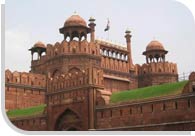Golden Triangle

Humayun's Tomb

Akshardham Temple

Red Fort

Qutub Minar



This 17th century architectural piece is considered Delhi's most magnificent monument. The Red Fort was built by Emperor Shah Jahan in 1638 A.D. Originally known as Qila-e-Mualla, the fort was built by the Mughal Emperor after he transferred his capital to Shahjahanabad (Delhi) from Agra in 1638. The monument is called Red Fort because of the ample use of red sandstone walls and and its octagonal shape. Shah Jahan laid the foundation stone of this majestic fort in 1639 and it was completed after nine years in 1648. Ustad Hamid and Ahmad, two expert Mughal architects supervised the construction of Red Fort.
Popularly called “Lal Quila”, the monument is visited for:
The War Memorial Museum is housed on the first floor, which is another delight to travellers. The southern end hall of the palace is called Mumtaz Mahal, and houses the Museum of Archeology (popular for the artifacts salvaged from the royal palace). The northern and southern sections of Red Fort were called Sheesh Mahal. Apart from all these attractions, the Khas Mahal is a place worth visiting for its extremely beautiful architecture. It was the emperor's palace with special rooms for private worship and for sleeping. The place is decorated with several miniature paintings of Shah Jahan.
The two main gateways are the Lahore Gate and the Delhi Gate. The entrance is made through the Lahore Gate, constructed of dull pink sandstone.
Political Importance
This 17th century Mughal marvel is one of the 26 Indian sites that are included in? UNESCO's list of World Heritages. The Prime Minister of India hoists the nationsl flag, and addresses the nation from the ramparts of the Red Fort on the auspicious day of India's Independance, August the 15th, every year.
The Sound and Light Show
One can witness the age old history associated to the Red Fort in the evening at the sound and light show. The shows are conducted in English and Hindi, and tickets are available at the Fort.
 Golden Triangle with Kerala & Mumbai
Golden Triangle with Kerala & Mumbai Golden Triangle with Ranthambore
Golden Triangle with Ranthambore Golden Triangle with Himalayan Monasteries
Golden Triangle with Himalayan Monasteries North India Temple Tour
North India Temple Tour